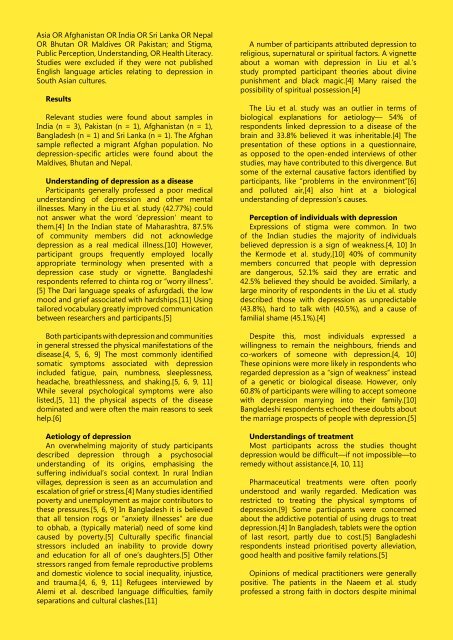Vector Volume 12 Issue 2 - 2018
You also want an ePaper? Increase the reach of your titles
YUMPU automatically turns print PDFs into web optimized ePapers that Google loves.
Asia OR Afghanistan OR India OR Sri Lanka OR Nepal<br />
OR Bhutan OR Maldives OR Pakistan; and Stigma,<br />
Public Perception, Understanding, OR Health Literacy.<br />
Studies were excluded if they were not published<br />
English language articles relating to depression in<br />
South Asian cultures.<br />
Results<br />
Relevant studies were found about samples in<br />
India (n = 3), Pakistan (n = 1), Afghanistan (n = 1),<br />
Bangladesh (n = 1) and Sri Lanka (n = 1). The Afghan<br />
sample reflected a migrant Afghan population. No<br />
depression-specific articles were found about the<br />
Maldives, Bhutan and Nepal.<br />
Understanding of depression as a disease<br />
Participants generally professed a poor medical<br />
understanding of depression and other mental<br />
illnesses. Many in the Liu et al. study (42.77%) could<br />
not answer what the word ‘depression’ meant to<br />
them.[4] In the Indian state of Maharashtra, 87.5%<br />
of community members did not acknowledge<br />
depression as a real medical illness.[10] However,<br />
participant groups frequently employed locally<br />
appropriate terminology when presented with a<br />
depression case study or vignette. Bangladeshi<br />
respondents referred to chinta rog or “worry illness”.<br />
[5] The Dari language speaks of asfurgdadi, the low<br />
mood and grief associated with hardships.[11] Using<br />
tailored vocabulary greatly improved communication<br />
between researchers and participants.[5]<br />
Both participants with depression and communities<br />
in general stressed the physical manifestations of the<br />
disease.[4, 5, 6, 9] The most commonly identified<br />
somatic symptoms associated with depression<br />
included fatigue, pain, numbness, sleeplessness,<br />
headache, breathlessness, and shaking.[5, 6, 9, 11]<br />
While several psychological symptoms were also<br />
listed,[5, 11] the physical aspects of the disease<br />
dominated and were often the main reasons to seek<br />
help.[6]<br />
Aetiology of depression<br />
An overwhelming majority of study participants<br />
described depression through a psychosocial<br />
understanding of its origins, emphasising the<br />
suffering individual’s social context. In rural Indian<br />
villages, depression is seen as an accumulation and<br />
escalation of grief or stress.[4] Many studies identified<br />
poverty and unemployment as major contributors to<br />
these pressures.[5, 6, 9] In Bangladesh it is believed<br />
that all tension rogs or “anxiety illnesses” are due<br />
to obhab, a (typically material) need of some kind<br />
caused by poverty.[5] Culturally specific financial<br />
stressors included an inability to provide dowry<br />
and education for all of one’s daughters.[5] Other<br />
stressors ranged from female reproductive problems<br />
and domestic violence to social inequality, injustice,<br />
and trauma.[4, 6, 9, 11] Refugees interviewed by<br />
Alemi et al. described language difficulties, family<br />
separations and cultural clashes.[11]<br />
A number of participants attributed depression to<br />
religious, supernatural or spiritual factors. A vignette<br />
about a woman with depression in Liu et al.’s<br />
study prompted participant theories about divine<br />
punishment and black magic.[4] Many raised the<br />
possibility of spiritual possession.[4]<br />
The Liu et al. study was an outlier in terms of<br />
biological explanations for aetiology— 54% of<br />
respondents linked depression to a disease of the<br />
brain and 33.8% believed it was inheritable.[4] The<br />
presentation of these options in a questionnaire,<br />
as opposed to the open-ended interviews of other<br />
studies, may have contributed to this divergence. But<br />
some of the external causative factors identified by<br />
participants, like “problems in the environment”[6]<br />
and polluted air,[4] also hint at a biological<br />
understanding of depression’s causes.<br />
Perception of individuals with depression<br />
Expressions of stigma were common. In two<br />
of the Indian studies the majority of individuals<br />
believed depression is a sign of weakness.[4, 10] In<br />
the Kermode et al. study,[10] 40% of community<br />
members concurred that people with depression<br />
are dangerous, 52.1% said they are erratic and<br />
42.5% believed they should be avoided. Similarly, a<br />
large minority of respondents in the Liu et al. study<br />
described those with depression as unpredictable<br />
(43.8%), hard to talk with (40.5%), and a cause of<br />
familial shame (45.1%).[4]<br />
Despite this, most individuals expressed a<br />
willingness to remain the neighbours, friends and<br />
co-workers of someone with depression.[4, 10]<br />
These opinions were more likely in respondents who<br />
regarded depression as a “sign of weakness” instead<br />
of a genetic or biological disease. However, only<br />
60.8% of participants were willing to accept someone<br />
with depression marrying into their family.[10]<br />
Bangladeshi respondents echoed these doubts about<br />
the marriage prospects of people with depression.[5]<br />
Understandings of treatment<br />
Most participants across the studies thought<br />
depression would be difficult—if not impossible—to<br />
remedy without assistance.[4, 10, 11]<br />
Pharmaceutical treatments were often poorly<br />
understood and warily regarded. Medication was<br />
restricted to treating the physical symptoms of<br />
depression.[9] Some participants were concerned<br />
about the addictive potential of using drugs to treat<br />
depression.[4] In Bangladesh, tablets were the option<br />
of last resort, partly due to cost.[5] Bangladeshi<br />
respondents instead prioritised poverty alleviation,<br />
good health and positive family relations.[5]<br />
Opinions of medical practitioners were generally<br />
positive. The patients in the Naeem et al. study<br />
professed a strong faith in doctors despite minimal<br />
25

















